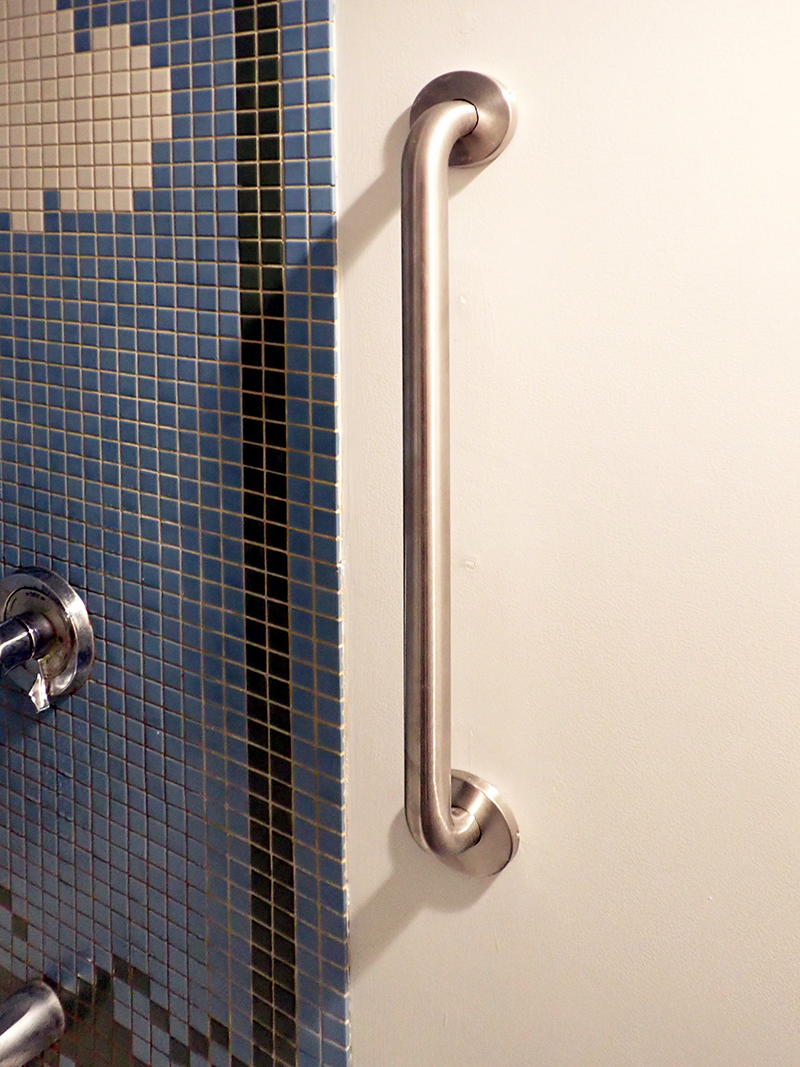
Like other human beings over the age of thirty, I am gradually losing muscle cells. That has been going on for a while now. To complicate matters, I have a congenital abnormality that leaves my left leg weak. I never was able to stand on it alone.
To a considerable degree, as we age we are able to compensate for gradual declines because we self-regulate: we recognize our evolving limitations, and adapt our behavior accordingly.
So it is with me and the daily shower. I have never slipped or even had a near miss, but have been feeling less comfortable getting out of the wet tub. And I am conscious that falls in general, and broken hips in particular, often are the decisive point in the loss of independence.
And so, recently I put in a grab bar. I find myself feeling not at all embarrassed at the badge of aging, but very happy that now I have this security. It is a bit like having a seat belt in a car or a helmet for vigorous physical activities.

Gutters are problematic building parts. Their purpose is to conduct water away; a good thought. But they are prone to clogs from leaves, ice dams, and mechanical damage. Some people consider the cure worse than the disease.
My attitude is neutral, except – to begin at a different point – the bulkhead leading to my basement was perfectly designed and placed to lead rainwater inside. Its rim was placed below grade. Then previous occupants then put impervious asphalt around the area draining toward the bulkhead, rather than steering it away or even giving it a chance to seep into the ground. The foundation had crumbling, shoddily placed concrete at its top. The bottom edge of the doors did not project outside of the foundation, but ended in the middle, so that water draining down was as likely to go inside as outside. All of these problems I solved, one by one. (A really good solution would have been to tear out the whole structure, but that would be a project and a half, to make a long story short.)
All of these band-aid repairs have worked well enough, except when the bulkhead is deluged with water from above. Alas, that happens whenever the gutter becomes clogged and a storm comes along. With large spruce trees nearby, cleaning becomes not just an annual chore, but a task that arises every few months.
So, I took the project of gutter screens off of the back burner. My schedule is rather backlogged right now, what with one thing and another, so the timing was unfortunate. But water had come into my basement just once too often. I bought a cordless nut driver for the purpose, which was pretty much a necessity. The nut driver is a drill as well, so as a side effect I have moved into a new age of tools… beyond the old Milwaukee drill that my grandfather could have owned (though he didn't).
I have completed the installation on the troublesome south side of the house. It took me three hours. Stay tuned! We'll see if next year I get around to the north side. Meanwhile, I will hope that the fates will not bring some new, unimagined way of getting water past all of my defences and devices, and into my basement.

The concept of health, whatever health is – beyond survival – is interwoven with conformity to expectations and norms. Body and soul go together. The question "What's wrong with you?" suggests deliberate deviance from basic norms. Being "sick" may entail isolation, perhaps stigma, even shame.
The moral perspective has loomed particularly large in the case of mental illness; if there is nothing visibly wrong with the body, the soul must be at fault. In the era of my grandparents, mental illness was something unspeakable and inadmissible. That attitude lingered on into the time of my parents, and is not gone today. One part of my maintaining a web site for my mother![]() was to communicate with her family when she no longer could, but another was to bring mental decay out of the closet. Heavens, she didn't deliberately decide to get Alzheimer's disease!
was to communicate with her family when she no longer could, but another was to bring mental decay out of the closet. Heavens, she didn't deliberately decide to get Alzheimer's disease!
Let me also move toward bringing another illness class out of the closet: gut disorders.
I am aging. Recently my PCP suggested to me that my gut was probably slowing down. Although I hadn't complained of the issue, I said, OK, that makes sense, all other parts of my body that I can see and feel are slowing down. He suggested I consider a common over-the-counter medication to speed things up sometimes. Again, I said OK, and a few weeks later I did try it.
It certainly did speed things up, to the point of creating a disaster that lasted close to a month. I was unable to trust myself away from home for more than an hour or so and cancelled everything, except brief trips to the grocery store after extended fasting. I lost weight and became markedly deconditioned. It was by far the worst spell of health in my life. Enough said.
In August, my PCP was away and others in the office did not respond to strongly worded messages. It was hardly a matter for calling 911, so I did my best on my own, for a long time without success.
Eventually, I tried a process that, seredipitously, seemed to have done the trick before. In 2017, I had a colonoscopy, preceded by the usual bowel preparation. The longstanding problem I had with runner's diarrhea ended immediately and abruptly afterwards. In 2025, I repeated the process, but without the colonoscopy. Again, the bowel problem came to a clean stop.
It sounds like something out of the dark ages, when medical treatments aimed to purge the body of unbalanced ill humors. Where is the biological plausibility?
The 2017 colonoscopy itself was not intended to address the runner's diarrhea, had no diagnostic findings, and included no intervention. More plausibly, the bowel preparation had cleaned some noxious thing out. My PCP at the time and I theorized that it was bacterial, either a nosocomial infection from an earlier colonoscopy or an unusual drift in the makeup of the gut microbiome. The bowel preparation brought a fresh start, allowing the reservoir of beneficial bacteria in the appendix to repopulate the intestine. My current PCP is more suspicious of hard lumps of fecal matter. In any case, a thorough cleaning out could be a good approach.
For the second time, the cure was total and near-instant.
Many trained health care providers regard my story with ill-concealed skepticism to overt contempt. I would counter that there is much about the gut that the science of 2025 doesn't pretend to understand: for starters, runner's diarrhea, the function of the appendix, and the workings of the microbiome and associated immunities.
In any case, my problem has totally gone away, saints be praised! I hope that the current state continues for a while.

The COVID-19 era brought the end of many things, some of them beloved.
One of my favorite grocery specialties was a brandless local pecan-raisin bread. It was a bit like a desert treat without a lot of sugar. It was just the thing for turkey sandwiches! I was sad to see it disappear in the early days of the pandemic.
A few weeks ago it reappeared on the shelves of the local Market Basket grocery chain, sporting the bright label, NEW ITEM. Actually, it is just the same as it was, delivered at the former par level of two loaves per day per outlet, but after a five-year absence, it deserves attention anew.
It's not quite as amazing as would be a modern wooly mammoth, but its reincarnation makes me happy.
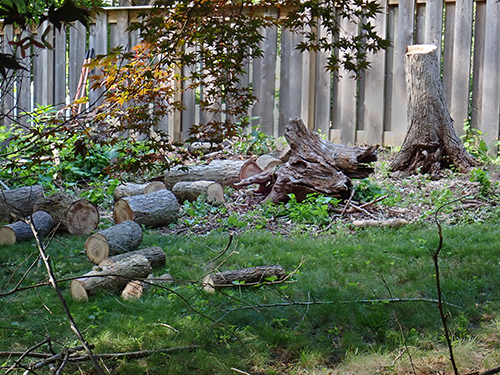
As I noted earlier, this year has not been kind to my trees. Yesterday I completed the second of three planned fellings, taking down a medium-sized slippery elm some decades old. I am not sure what killed it. I found no trace of the bark beetles that often transmit Dutch Elm Disease, but gather that the fatal fungus may spread by other means. Curiously, the sap was up and full in the trunk, but the limbs were dry and had nary a leaf.
Cutting down the tree was not strenuous, but rolling around the downed trunk for cutting into sections was more demanding. A logger's peavey would have been just the thing for that task, but I'm not quite ready to spend $100 for a tool that I might use once every few years. (As you can see if you look closely at the picture, I felled a larger tree and unearthed its stump by hand a few years ago.)
After an unusually smooth period at the start of the year, I have been experiencing a mini-chain of unexpected events that is setting my planned activities behind where I had hoped they would be by now. These include the failure of my electronic sound system, shortly thereafter the total failure of my home phone and internet systems, and then the incompatibility of my working printer with the new WiFi router. All of these are issues I can work through, but each has knocked out a couple of days' worth of free time.

This picture reminds me of my grandmother pointing at the thermometer in the full Kansas sun, saying that it was hot enough to fry an egg on the sidewalk. On the farm, there was no shortage of eggs, and my childhood memories retain the event of her actually trying the experiment. It didn't work, but I'm sure that didn't faze her. Not much did.
Well, we're not supposed to pay attention to what a thermometer in the sun reads. I have another one in a shaded location, which is showing 104°. The Weather Channel is reporting 100°. The National Weather Service has 98°. You get the idea.
I went out early for a hike. The temperature rose from 75° to 90° in the two hours I was out. I must say, I was tired at the end of it.
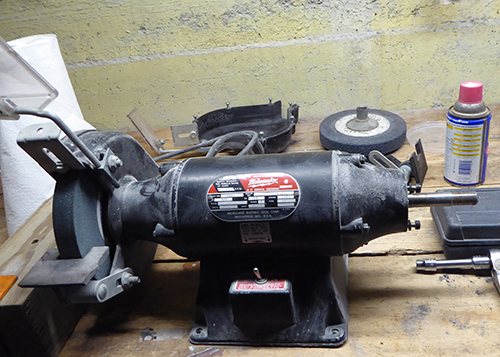
Milwaukee Tool has a strong reputation for quality and reliability. As I read somewhere, you may still have the Milwaukee drill that belonged to your grandfather. Actually, I do have one I bought some fifty years old, and it is still going strong.
I also have a bench grinder of the same vintage. After five decades, one of its ball bearings was worn and screeching dreadfully. I bought a pair of bearings for $8.95 each. I was surprised and impressed that the parts were still available, though Milwaukee has ceased making bench grinders of all kinds.
As a comparison, a few years ago I bought a hand-held grinder made by another well-reputed company. The tool bearings gave out after a year and a half. On investigation, I found that bearing replacement was not a service an owner could perform. The nearest factory-owned repair shop is forty miles away from me.
Small repair shops have gone the way of small retail businesses.
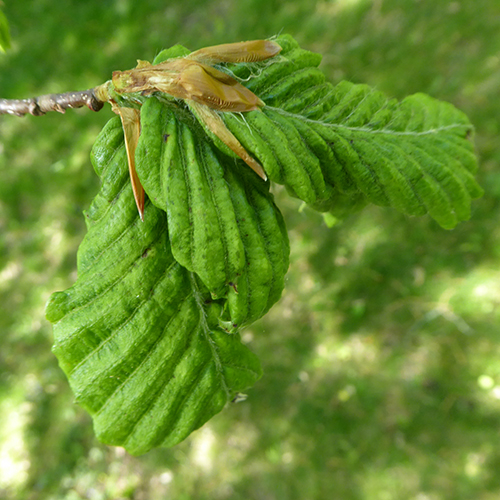
It's spring, when everything comes back to life again.
Except when it doesn't.
I have been very careful in selection of trees and shrubs for planting in my yard, limiting the choices to varieties I have long seen flourishing in the area. I plant an experimental specimen and observe it for at least a year before adding others of its kind.
This year, things are not looking very good. My rhododendrons, a series going back four years, have acquired weevils – which I recognize as a hazard for them. Others up and down the street are doing just fine. There are treatments for this issue, but the better ones are laborious and work only for the short term. (One approach, advocated as environmentally sound, would be to pick the weevils by hand off the bottoms of the leaves at night, using a flashlight).
Beech trees are famously sturdy and long-lived, growing for centuries. Mine, started some fifteen years ago, are developing beech leaf disease, a fatal and incurable ailment thought to be nonnative to America. The disease has emerged nationally only in the last few years, after I planted mine.
An existing elm-like tree, carefully pruned and observed, was apparently in excellent health last fall. It simply did not leaf out this year, no reason apparent. This is not the natural history of Dutch elm disease, which manifests itself gradually.
Sigh.

When I recently went to a sunsetting antique store looking for a cabinet, I happened across a box of rusty woodcarving tools, sculptor's carving gouges, which are quite specialized and very expensive bought new. I told myself, you have more than enough of such stuff already and you won't ever use them. So, I had the self-discipline to pass them by.
I regretted my fortitude frequently and intensely over the next few days. To make a long story short, I returned and bought the tools for $20. New, they would have cost about $400. I have cleaned and sharpened the new tools as well as the old ones.
I enjoy woodworking, as do many others. I draw no particular line between high and low art. I might have built the cabinet I was looking for, but that would have taken a sizeable shop and a lot of heavy machinery, with expenses probably running into five figures.
As far as "Art with a capital A," I am very happy with the result that I achieve (on a good day) with stone carving. The process is something else. Because stone is so hard, the steps are nothing if not planned. Most often, I make a full-scale styrofoam model beforehand. Working the stone is a noisy, dusty process, requiring a lot of personal protective equipment. Most of the time, it needs to be done outdoors. It takes me half an hour to set up and break down a work session. Overall, it typically takes me a year from first sketches to a finished product.
I recently happened across a picture of a carved root that caught my fancy. I am working on an experimental piece of my own now, with pleasing results so far. I can go down to my cellar and work on it for five minutes on whim, and walk away anytime I like. I am elaborating within a form that is intrinsically organic. Nature is more creative and profound than I am.
I wonder if I can find a good source for intriguing stumps.
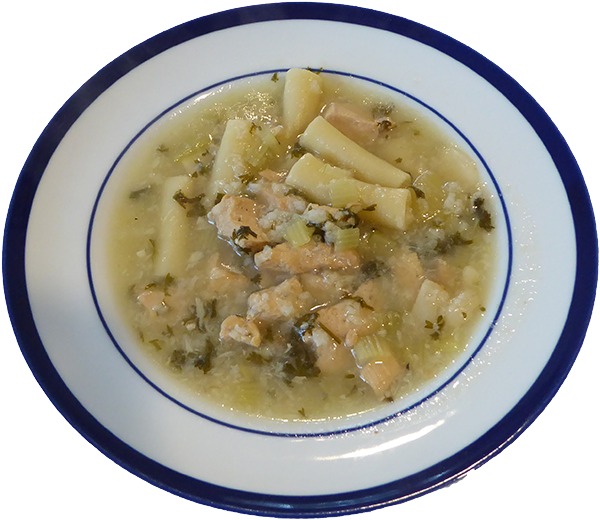
An earlier version of this website had a lot of material on cooking. I won't start time travel backwards, but I will report one variant on a very common dish that is worthy of note: chicken soup.
Nearly all of the chicken soup recipes I find today include an onion and carrots. The recipe here has neither. It is for a hearty dish that might be considered closer to a stew than a soup. It is a chicken-focused recipe, not a vegetable soup with a broth base.
The key ingredients are a couple of chicken thighs, diced (or less good, a breast), a quarter cup of peeled garlic cloves, some parsley, and a quarter cup of mirin – a rice wine used in Japanese cooking. The mirin adds savoriness, one of five basic tastes.
I agree with the common inclusion of noodles of some sort, or rice.

I enjoy a game of solitaire as part of my evening ritual, just as at other times I enjoy a crossword puzzle (of the British cryptic variety, rewarding cleverness, not the American style, measuring knowledge of trivia from the mass entertainment media). It is a fifteen-minute interlude in a life filled with tasks whose duration is measured in months.
I play a game called Freecell, as did my mother. Heaven knows where she learned it. It was popularized by Microsoft, but I'm sure she didn't get it there. She used a deck of traditional playing cards, as do I. I find it's as useful to keep my hands busy as my mind! – The one in the picture is six years old, two or three times the expected lifetime of an electronic device.
Freecell, unlike the much more popular solitaire games of Klondike and Pyramid, is almost always winnable, and calls for some skill and attention. In fact, it calls for enough of one's attention that other thoughts must be set aside. That is not a bad pre-bedtime condition.
Recently, I looked around to see if there were other solitaire games winnable with skill. I came across Accordion, which comes in different varieties. For a long time, it was considered nearly unwinnable, until somebody figured out an approach that almost always works. It does call for much concentration, so is still widely considered very difficult.
Accordion, unlike most other solitaire games, is not an exercise in sorting, but of matching and collapsing – hence the name. As such, it calls for different skills.
Unfortunately, I found little of value on strategy for the game. There is not even an accepted system of notation for recounting it, as there is for chess or bridge. So, I have created my own brief guide ![]() and notation system.
and notation system.
The sample game I describe is a relatively easy one. I invite comment.
Accordion does take some space, which is a challenge for someone who tends to build up clutter on the kitchen table. But adjusting that habit would not be a bad thing, either.

Last winter was very mild. The ground barely froze. I was able to get a jump, months early, on a pile of spring chores that is usually overwhelming.
This winter has offered unrelenting cold. The amount of snow has not been great, nor have there been extremely low temperatures. But the days when the thermometer cracks freezing have been few, and when they've come, often with gusty winds. My last monthly gas bill was over $500, far above the norm.
It's January. One should expect such things. I do have more than enough indoor activities, and have been getting better at having a balance of things that require thinking and things that don't. (A warm day, or even a warm afternoon, would be nice for a couple of pending tasks… one will come.)
The snows at least have been pretty ones.

Though early January morning weather has been offering a wind chill factor of 0° F, it turns out that there have been good opportunities for field observation, prompted by my new lichen book.
The growth here is a common greenshield lichen, one of the most prevalent varieties globally and locally. It is a symbiotic combination of a fungus (Parmelia sulcata) and a green microalga (Trebouxia).
The microalga component has the capability of photosynthesis, deriving nutrient energy from the air and sunlight. It is notable here that the lichen displays a greenish tint even in mid-winter, in contrast to most of the deciduous plant life around it, now dead, brown and yellow.
The cells of the fungus are filamentary. As my reference notes, these threadlike structures weave into and around the alga, providing a firm base and skin. The durability of the composite is evident in the photograph. The lichen is still present and evidently alive, hanging loosely around the branch, long after the tree itself has died, the bark has dropped, and the wood itself is in marked decay.
© 2025 Paul Nordberg